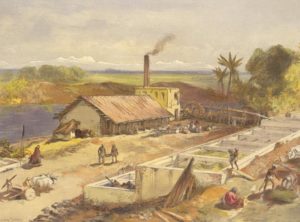By Pamela Toler (Regular Contributor)
Save
In the fall of 1859, two years after the violent uprisings in Northern Indian known as the Indian Mutiny or Sepoy Rebellion, thousands of peasant-farmers (ryots) in the Indian province of Bengal refused to accept cash advances to plant indigo crops in the spring, an act of resistance that became known as the Blue Mutiny.
An Industry Built on Oppression
Property laws in Bengal had put European indigo planters in conflict with ryots ever since commercial indigo growing was introduced to Bengal at the end of the eighteenth century. Europeans were not allowed to own land, so planters had to contract with ryots to grow indigo for them in the ryots‘ fields.
From the first, ryots were reluctant to grow indigo, which was sown and harvested at the same time as rice, their primary food crop. Planters used both trickery and violence to force unwilling ryots to plant indigo. Some forged contracts. Others resorted to beatings, looting, arson, kidnapping, and even murder to force ryots to accept cash advances.
Once a ryot had accepted an indigo contract, willingly or not, he received a cash advance in the fall to plant indigo the following spring–a system similar to sharecropping in the American South after the Civil War, with many of the same inherent pitfalls for the farmer. In theory, the ryot would repay his advance and make a small profit after harvesting his indigo. In bad years, expenses exceeded advances and ryots went in debt to planters. Even in good years, planters often did not pay ryots what they were owed at the end of the growing season. Many used the threat of unpaid debts to force ryots to continue planting indigo year after year.
Ryots had little recourse against the planters, who were supported, both officially and unofficially, by British officials. Isolated outbreaks of violence against planters and indigo factories occurred as early as 1809, but were quickly suppressed by the police. On the rare occasions when ryots took the expensive and difficult step of going to court, magistrates generally supported the planters.
The Ryots Push Back
The system was inherently unstable: profits depended on both prices on the world indigo market and good crop yields. In the 1830s and 1840s, crops were good and “Bengal blue” dominated the world indigo markets. From 1847 through 1858, bad weather reduced the average annual indigo crop yield by 23% compared to the previous decade. While indigo profits dropped, market prices for jute, linseed, and rice rose, making indigo contracts even less appealing to ryots.
At the same time, the relationship between government official and planters was disrupted. In 1858, in response to the Indian Mutiny, the British Crown replaced the East India Company as India’s ruler. Crown rule brought administrative changes at every level of the government. Smaller district divisions made it easier for ryots to bring their complaints to court. More importantly, young magistrates, hired under a system of competitive examinations, occasionally ruled in favor of ryots in disputes between ryot and planter. Word spread that the government would not force ryots to grow indigo.
When ryots refused to accept indigo advances in 1859, planters reacted the way they had in the past, leading armed bands to force ryots to accept the advances. This time, some villages fought back.
Over the course of the next two years, violent responses to planter oppression spread throughout Bengal. Both planters and ryots appealed to the government for aid. Ryots flooded officials with petitions for relief from specific planters’ abuses. Planters called for laws that would make breaking an indigo contract a criminal offense. The courts overflowed with indigo cases.
In 1860, the Lieutenant Governor of Bengal appointed a commission to investigate conditions in the indigo industry. For four months, members of the Indigo Commission heard testimony from every group with an interest in indigo. The Commission’s final report described an industry built on violence, coercion, and oppression, but the Commissioners were not able to agree on solutions and the government took no action.
A Temporary Peace
By the middle of 1863, uneasy peace had been restored to the indigo districts, largely as a result of the resolution of hundreds of indigo cases in the courts that exposed planter abuses and clarified ryots’ rights. Pressured by public opinion, some planters re-negotiated their relationships with ryots; others gave up indigo entirely.
Improved relations between planters and ryots were not permanent. When aniline dyes threatened to destroy the indigo industry, planters put new pressures on their workers. In 1916, Indian indigo workers once again protested the conditions under which they lived and worked, led by a young activist named Mohandas Gandhi.

